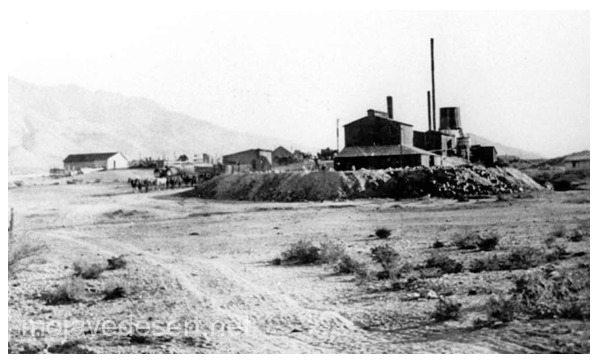The Historical Mining Towns of the Eastern Mojave Desert
By Alan HensherIn 1869, a prospecting expedition discovered copper and silver veins
in the Clark Mountains. A supply center, named Ivanpah, arose at Ivanpah
Spring, several miles from the silver deposits; the two main properties
became the Beatrice and Lizzie Bullock. Mills were built at Ivanpah in
the mid-1870s. The district reached its peak about 1879 and then
declined rapidly during the early 1880s.

Copper World smelter, Rosalie, c.1898
The Copper World, the other major strike, was developed in 1898, when a
smelter was built at nearby
Rosalie Wells. Although
the production was
large at times, the operations were erratic, and the Copper World shut
down about World War I.
In 1879, gold and silver were found near
Mountain Pass. This became
the
Mescal Mine. The property was developed in 1882 and remained active
at least into 1887. The Mescal produced an estimated $250,000 in
bullion.
Silver ore was discovered in the
Providence Mountains in 1880. The
main property was the
Bonanza King Mine. Two
speculators in Colorado,
Wilson Waddingham and Thomas Ewing, bought the property several years
later. They built a mill at a nearby spring and sank a deep shaft. After
producing $1,500,000 in bullion, the mill burned in 1885; as the price
of silver declined, mining became erratic, and work in the district
ended during the early 1890s. The Bonanza King was revived in 1906-1907
and 1915-1920.
Bob Black, an Indian, struck gold ore near Vanderbilt Spring, in the
New York Mountains, in 1891, when a tent camp was founded. In late 1892,
major development began. The main mines were the Gold Bronze and the
Boomerang. Meanwhile, the
Nevada Southern Railway
was built into the
area, and a railhead was established at Manvel. The veins were small,
and the districtís two mills were inefficient. The district began to
decline in 1894, though some mining continued through the late 1890s.
Several prospectors from
Goldfield, Nevada,
found gold in the Castle
Mountains in late 1907. A town named Hart was founded in early 1908, and
a mill was built. The leading properties were the Oro Belle, Big Chief,
and Hart Consolidated, but the veins were small and broken, and the
district began to decline in 1909. Occasional mining continued until
about 1915.
Mining began in the Vontrigger district during the 1890s, but the mines
were small. After 1904, Albert H. Cram, a promoter, developed a copper
deposit known as the California Mine, north of
Goffs. He built a large
camp and installed a leaching operation, which produced some copper. The
nearest shipping point was Vontrigger, on the
California Eastern Railway,
two miles away. Cram discontinued work about 1911. Several
miles to the west, in the Hackberry Mountains, the Getchell Mine was
developed in 1925, and a large camp, also named Vontrigger, was built
there, but the work soon stopped.
Ivanpah
Mescal
Providence
Manvel
Vanderbilt
Hart
Vontrigger
This paper was published as:
Hensher, Alan, 2005, Robert E. Reynolds editor, Old Ores, Mining History in the Eastern Mojave Desert: California State University, Desert Studies Consortium and LSA Associates, Inc.